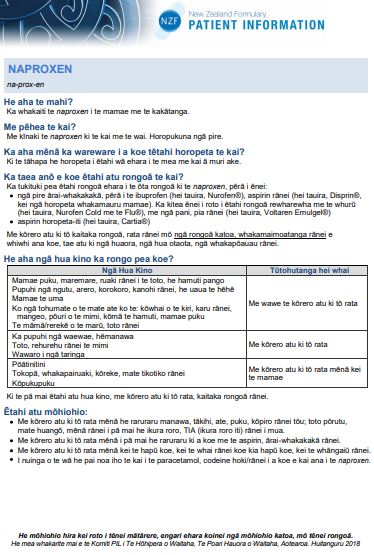Naproxen
Sounds like 'na-prox-en'
Key points about naproxen
- Naproxen is an anti-inflammatory used to treat pain and inflammation.
- Naproxen is commonly called Noflam® and Naprosyn SR®.
- Find out how to take it safely and possible side effects.

Naproxen belongs to a group of medicines known as non-steroidal anti-inflammatory drugs (NSAIDs). It's used to treat different types of pain such as period pain and pain from injury or after surgery.
NSAIDs are also used to ease pain, swelling and stiffness associated with flare-ups of gout, osteoarthritis, rheumatoid arthritis and ankylosing spondylitis. NSAIDs block the inflammation process to ease swelling and pain.
In Aotearoa New Zealand naproxen is available as tablets.
- Tablets come as immediate release and slow release (SR).
- The immediate release tablets (250 mg and 500 mg) are useful where immediate pain relief is required, and the slow release tablets (750 mg and 1000 mg) are more useful in reducing long term inflammation.
- This medicine is only available with a prescription from a prescriber.
The dose of naproxen will be different for different people. As a guide:
- For a long-term condition (eg, arthritis), the usual dose is 500 mg to 1 gram per day, taken as either a single dose or divided into 2 doses during the day.
- For short-term conditions (eg, muscle/tendon pain or sprains/strains), the usual dose is 250 mg, 3 or 4 times a day when needed. It's often recommended that a double dose (500 mg) is taken for the first dose.
- For gout pain, the usual dose is 750 mg for the first dose, and then 250 mg every 8 hours until the flare has passed.
- For period pain, the usual dose is 250 mg 3 to 4 times a day for up to 5 days. It's often recommended that a double dose (500 mg) is taken for the first dose.
Always take your naproxen exactly as your healthcare provider has told you. The pharmacy label on your medicine will tell you how much to take, how often to take it, and any special instructions.
- Food: Take naproxen with food or immediately after food, to prevent stomach upset.
- Water: Take naproxen with a full glass of water.
- Take them whole: Swallow the tablets whole, don't crush or chew them.
- Missed dose: If you forget to take a dose, take it when you next need pain relief and then continue as before. Don't take 2 doses together to make up for a forgotten dose.
Taking naproxen with other pain medicines
Don't take other anti-inflammatory medicines such as diclofenac, ibuprofen or celecoxib while taking naproxen. This can increase your risk of side effects.
It's safe to take naproxen with paracetamol because they work differently.
Taking naproxen with blood pressure medicines
Naproxen interacts with some medicines, especially those used for high blood pressure, so check with your healthcare provider or pharmacist before you start taking naproxen.
Image credit: Healthify He Puna Waiora
Taking NSAIDs together with blood pressure medicines can be harmful to your kidneys. This is called the ‘triple whammy’. If you're taking blood pressure medicines (ACE inhibitors or ARBs) and diuretics tell your healthcare provider or pharmacist before starting naproxen. Talk to them about safe pain-relief options for you.
- Examples of ACE inhibitors are captopril, cilazapril, enalapril, lisinopril, perindopril and quinapril.
- Examples of ARBs are candesartan, irbesartan and losartan.
- Examples of diuretics are furosemide, bumetanide, bendroflumethiazide, chlortalidone, hydrochlorothiazide, indapamide, spironolactone, eplerenone and metolazone.
Read more about the triple whammy effect.
Here are some other things to know when you're taking naproxen
- You may only need to take naproxen for a few days, or long-term. It won’t cure your condition but helps to control pain, swelling and stiffness.
- If you’re not well: It can be harmful to take naproxen when you’re dehydrated (haven't drunk enough fluid) or have been sick with diarrhoea (runny poo) or vomiting (being sick). Read more about the risks of NSAIDs.
- Alcohol: Naproxen doesn't directly interact with alcohol. This means that most people could have the occasional drink while taking it without any serious problems. However, if naproxen makes you feel tired, dizzy or gives you a sore stomach, don't drink alcohol as it will make you feel worse.
- Driving: Naproxen can make you feel tired or dizzy. Be careful when driving or using tools until you know how this medicine affects you.
- Pregnancy or breastfeeding: Talk to your healthcare provider if you're pregnant, planning a pregnancy or want to breastfeed.
Like all medicines, naproxen can cause side effects, although not everyone gets them. If you're concerned about any symptoms you think might be related to your medicine, talk to your healthcare provider. The information below offers some guidance but doesn’t include all possible side effects.
Common side effects
Tell your healthcare provider if these side effects bother you.
- Heartburn (indigestion), sore stomach, runny poo (diarrhoea). Take naproxen with food.
- Headache.
- Feeling tired or dizzy. Don’t drink alcohol. Be careful when driving or using tools until you feel better.
Tell your healthcare provider immediately or phone Healthline free on 0800 611 116 if these occur
- Serious stomach problems such as really bad stomach pain, blood in your stool or black stools, cough or vomiting up blood or dark-coloured vomit
- Chest pain, shortness of breath or trouble breathing
- Signs of a stroke such as weakness in one part or side of your body and slurred speech
- Signs of kidney problems such as swollen ankles, blood in your pee or not peeing at all.
Phone 111 for an ambulance or go to your nearest accident and emergency (A&E) clinic if these occur
- Signs of an allergic reaction such as itchy skin, and rash, swollen lips or tongue, problems breathing, such as a tight chest or shortness of breath.
Read more about medicines and side effects and reporting a reaction you think might be a side effect.
The following links have more information about naproxen.
Naproxen(external link) NZ Formulary Patient Information te reo Māori(external link)
Naprosyn SR Modified release tablet(external link) Medsafe Consumer Medicine Information, NZ
Noflam(external link) Medsafe Consumer Medicine Information, NZ
Brochures
Naproxen in te reo Māori(external link) My Medicines, NZ, 2025
Medicines and side effects(external link) Healthify He Puna Waiora, NZ, 2024
5 questions to ask about your medications(external link) Health Quality and Safety Commission, NZ, 2019 English(external link), te reo Māori(external link)
At home sick day advice [PDF, 425 KB](external link) Health New Zealand | Te Whatu Ora, 2023
References
- Naproxen(external link) New Zealand Formulary
- Non-steroidal anti-inflammatory drugs(external link) New Zealand Formulary
- Noflam(external link) Medsafe datasheet, NZ, 2023
- Naprosyn SR(external link) Medsafe datasheet, NZ, 2022
- Reclassification of naproxen(external link) Medsafe, NZ, 2023
- Avoiding the triple whammy in primary care – ACE inhibitor/ARB + diuretic + NSAID(external link) BPAC, NZ, 2018
Brochures

My Medicines, NZ, 2018

Medicines and side effects
Healthify He Puna Waiora, NZ, 2024

Health Quality and Safety Commission, NZ, 2019 English, te reo Māori
Credits: Healthify editorial team. Healthify is brought to you by Health Navigator Charitable Trust.
Reviewed by: Stephanie Yee, Pharmacist, Auckland.
Last reviewed:





